I remember once sitting in a quarterly marketing review meeting and watching competitors’ video campaigns flash across the screen.
My initial skepticism turned to curiosity as I saw how they engaged audiences in ways our traditional content never had. Each campaign told a story that spoke directly to the challenges and needs of a decision maker.
That’s when I realized: B2B video marketing isn’t just another checkbox in our marketing strategy – it’s a fundamental shift in the way we interact with our audience.
Think about it: An engaging explainer video can transform a confused prospect into an interested lead, while a well-crafted customer story can transform a hesitant decision maker into a confident buyer.
In this guide, I walk you through the evolution of B2B video marketing. You’ll learn how to develop a strategy that resonates with decision-makers at every stage of their journey, how to find the optimal balance between engagement and professionalism, and how to build a video presence that drives real business results.
No more guessing games and crowd following – just clear, actionable insights to help you create videos that actually work.
Table of contents
What is B2B Video Marketing?
In B2B video marketing, companies create and share video content to reach other companies, educate them about their solutions, and build professional relationships. These videos help provide thought leadership, demonstrate product value, and build trust with potential business customers.
B2B videos are no longer just “nice to have”.
Go to any business website today and you’ll likely see a play button within seconds. This isn’t just an aesthetic choice – web visitors now expect it.
The latest data shows why: Although 2023 was a year full of layoffs and budget cuts, video consumption has proven surprisingly immune to economic headwinds.
According to this, the total watch time for corporate content has increased by 44% compared to 2022 State of Video 2024 Report.
B2B video marketing signals the death of big-budget corporate productions.
These expensive, glossy corporate videos just can’t keep up with the trends I’m seeing.
Small brands that only have a webcam publish around 15 videos per year, competing with larger and more established brands.
And here’s what really catches my eye: Viewers are gravitating towards educational content that addresses real-world problems – this type of content now accounts for 47% of all business videos.
Viewers flock to this type of content looking for guidance and practical solutions.
B2B videos bring higher conversion rates.
When companies embed email signup forms into these videos, 23% of viewers take an action, a conversion rate that exceeds that of traditional CTAs, which average around 13%.
This shift isn’t just about getting more clicks; It signals a deeper shift in audience expectations of brands. You’re not looking for a sales pitch, you’re looking for a teacher, a guide, and a problem solver.
What is driving this change?
With 93% of companies now citing video as essential to their marketing strategy, industry experts point to two key catalysts: the role of AI in improving video creation and an audience increasingly drawn to video for its immediacy and depth.
Companies are using AI to optimize video production, from automated editing to personalized content creation, allowing marketers to produce high-quality, targeted videos at scale.
Here is a snapshot of various AI use cases in the video production workflow:
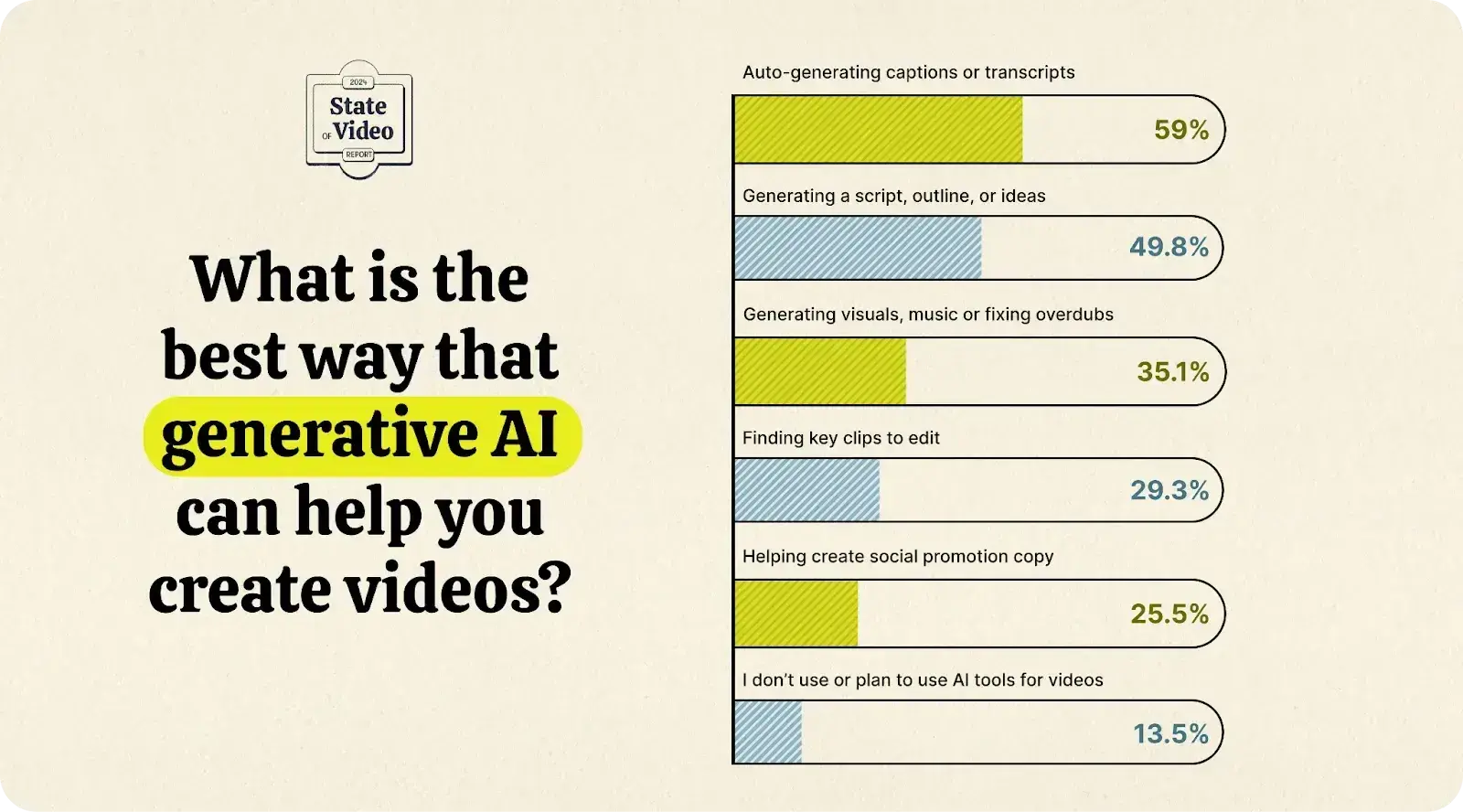
Image source
AI tools also enable advanced audience insights that help create more relevant and engaging content.
For marketers, the takeaway is clear: effective video marketing isn’t about budget – it’s about adopting a mindset that harnesses the power of AI to make content creation faster, smarter, and more responsive to audience needs.
B2B vs. B2C video marketing
Although both B2B and B2C video marketing are powerful tools, they are each designed to meet different audience needs and marketing goals.
B2B video marketing takes a strategic, targeted approach. It is aimed directly at company decision-makers in order to accompany them through longer sales cycles.
As Kean BartelmanDeputy Creative Director at Lemonlight, explains: “B2B audiences are often more willing to invest time in longer videos. There is more patience because the content is designed to provide depth and insight tailored to their needs.”
This longer format, often 2-10 minutes, allows for a detailed exploration of solutions and business value propositions.
However, the landscape continues to evolve. Bartelman notes, “We’re seeing a trend lately where a lot of B2B customers are asking us to give their creations a B2C feel. They want more flair, more cinematic elements and an overall approach that is compelling and entertaining.”
This shift reflects a mix of traditional B2B educational content with the engaging storytelling styles often found in B2C.
Through my experience being part of video campaigns for a SaaS platform, I have seen the direct impact of well-executed B2B video marketing.
By implementing detailed product demonstration videos with clear ROI calculations, we were able to increase the number of qualified leads by 30% and shorten the sales cycle by almost three weeks.
The key was to focus on addressing specific pain points and showcasing real customer success stories that resonated with multiple decision makers in the buying process.
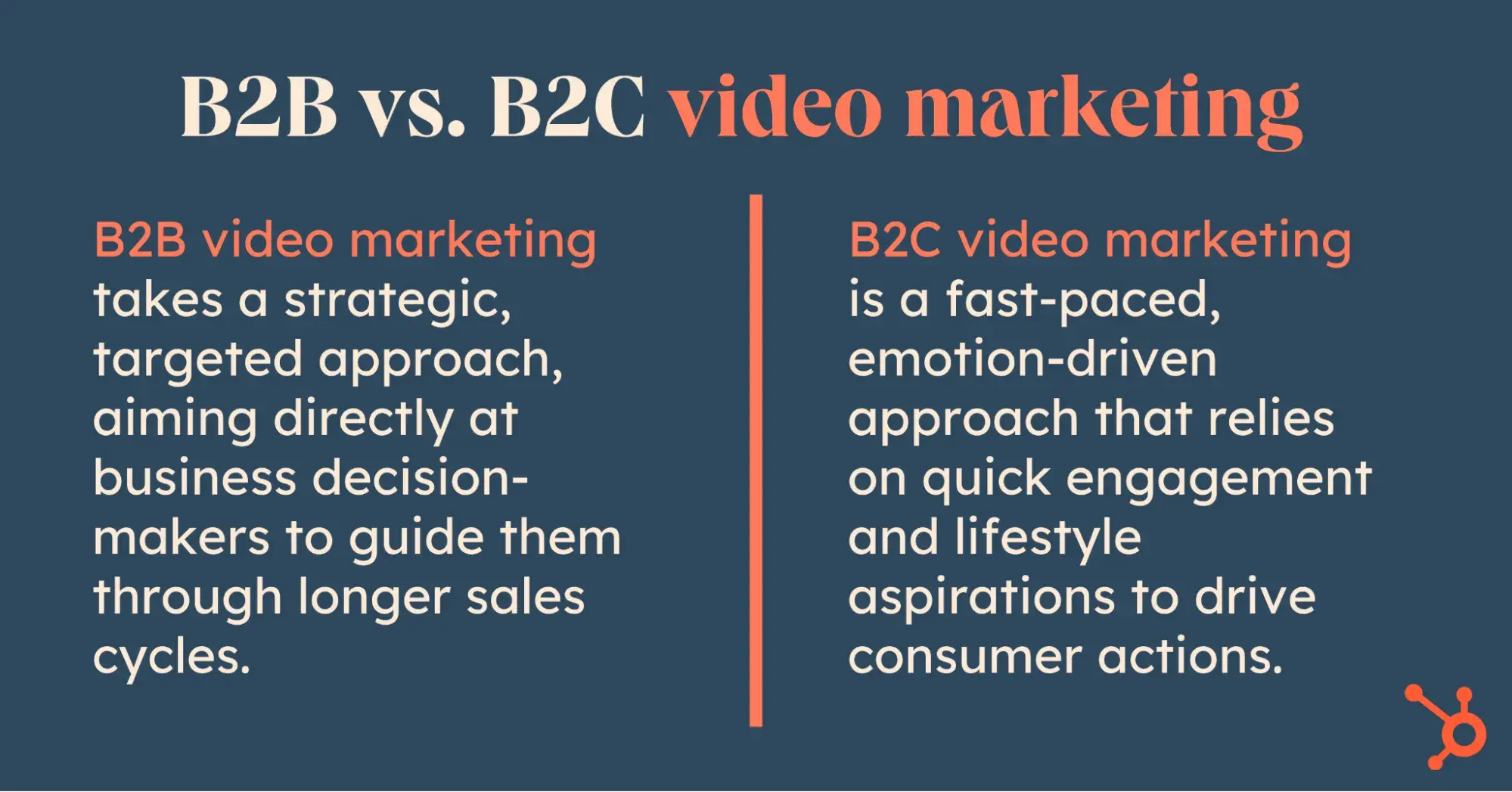
B2C video marketing, on the other hand, is a fast-paced, emotion-driven approach which relies on rapid engagement and lifestyle ambitions to drive consumer action.
The focus is on entertainment and an immediate emotional connection, typically through short videos.
For example, when I look at this Etsy videoI immediately sense the playful, personable tone aimed at individual buyers like me – definitely a B2C vibe.
The whole “Where’s Wally” concept is a clever way to connect with those of us who know what it’s like to feel lost in a crowd but to be seen deeply by people who really know us .
The video is about gifts that say “I hear you,” which speaks directly to me as a consumer looking for something special and personal.
It is not a corporate message; It’s a friendly reminder that Etsy is the place to find those unique items that will make someone feel truly understood.
The decision-making process focuses on individual consumers buying faster based on emotional factors.
Calls to action are more direct and immediate, such as “Shop Now” or “Tag a Friend,” with success measured using immediate sales and social engagement metrics.
According to HubSpot’s 2023 Video Marketing Report, B2C brands that use short-form video content see 30% higher engagement rates compared to traditional marketing methods.
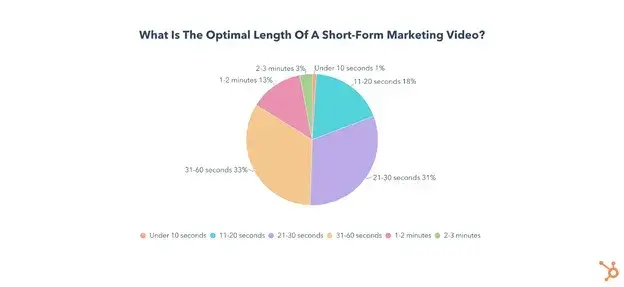
Image source
This shows how powerful video content can be for brands that want to create a real connection with their customers and get them to buy straight away.
Mastering video marketing requires a clear understanding of the gap between B2B and B2C landscapes – something that continues to define campaign success.
While B2B video marketing campaigns Navigate complex journeys with multiple stakeholders. B2C content leads to quick, emotion-driven decisions.
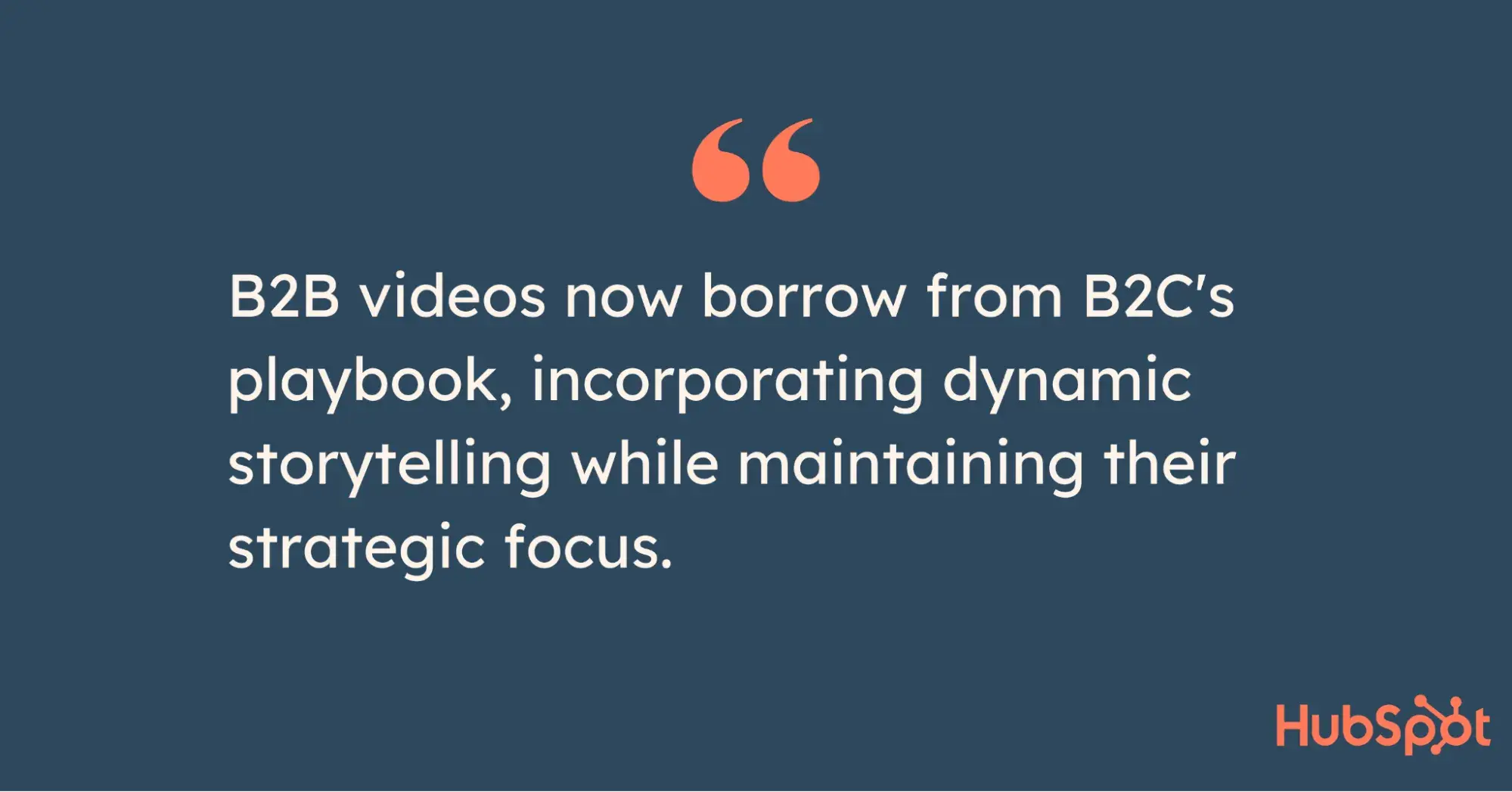
Nevertheless, the landscape continues to develop. B2B videos now lean into the B2C playbook and incorporate dynamic storytelling while maintaining their strategic focus.
The result? A sophisticated approach that takes into account platform dynamics and audience behavior while pushing creative boundaries.
Benefits of B2B Video Marketing
- Videos create trust among buyers.
- The video provides valuable insights into buyer preferences.
- Videos help teams deliver value-driven content.
- Videos attract new customers through social proof.
- Video drives personalized ABM strategies.
1. Videos build trust among buyers.
While traditional content marketing is effective at delivering insights, video takes it a step further by building a more personal connection with buyers.
In my experience, videos engage shoppers on a very personal level – seeing a product in action makes it feel more real and relatable than any description ever could.
When shoppers experience a product via video, they aren’t just informed; They have peace of mind, which is exactly what they need when making complex, high-risk decisions in a B2B context.
ServiceNow’s AI-driven explainer video is a prime example of how video content can effectively build trust.
This video shows how Now Assist addresses common workplace challenges in real-world scenarios and demonstrates that ServiceNow deeply understands the everyday needs of its B2B customers.
This approach builds trust by allowing buyers to imagine the impact of the product in their own workflows, moving beyond theory to practical, understandable use cases.
Instead of relying on abstract promises, the video demonstrates concrete, valuable results such as increased productivity and optimized processes, offering viewers a reassuring insight into the tool’s potential in practice.
Short-form social videos are increasingly trusted 63% of B2B buyers to turn to them to make informed decisions. ServiceNow’s polished, concise video fits this preference perfectly.
By balancing brevity and substance, the video respects the viewer’s time while providing enough detail to inspire trust.
This focus on real-world applications and immediate benefits makes the product more tangible and positions ServiceNow as a trusted, customer-centric provider.
For B2B buyers facing complex purchasing decisions, this type of video content is exactly what builds trust, credibility, and ultimately a stronger bond with the brand.
2. The video provides valuable insights about buyer preferences.
Video analytics provide unique insights into buyer behavior through detailed engagement data that traditional metrics like page views simply cannot match.
Audience engagement charts show exactly where prospects are focusing or losing interest, while heatmaps and repeat patterns show which features are grabbing attention and where clarification may be needed.
When I watch video analytics, I’m always struck by how much they reveal about buyers’ preferences. For example, if we can see exactly where someone pauses or rewinds, we can see what resonates the most.
I recently watched a video analytics demo from Wistia and it showed how powerful these tools can be.
The heatmaps not only showed where viewers were watching, but also showed exactly which sections viewers skipped or rewatched. This level of detail helps me pinpoint what’s working and what’s not in a way that’s almost impossible with other data.
For example, if I see that viewers are dropping off at a certain point in a video, I can see where we might need to restructure the content to keep them interested.
Or when I noticed that a particular section was being re-watched a lot, I realized that part was particularly exciting or needed to be highlighted further up in the video.
Additionally, the ability to use A/B testing for different video edits allows us to try out changes and immediately see which version performs better, allowing us to continually improve the content.
By considering these moments, we were able to refine our messaging to better align with what shoppers are really looking for.
These video-specific insights enable teams to optimize everything from product messaging to sales presentation flow, resulting in more targeted outreach and shorter sales cycles.
3. Videos empower teams to deliver value-driven content.
Video improves both sales and support interactions by enabling scalable personalization.
Research shows that 94% of buyers prefer demos tailored to their specific use case, and 38% are less likely to purchase if they have to contact sales for basic demonstrations.
With video, sales teams can create reusable, customizable demos that buyers can access on-demand, meeting this expectation of personalization.
This video strategy also optimizes support. By creating a library of tutorial videos, support teams can reduce response times and empower customers to find answers on their own.
In addition to increasing operational efficiency, video also creates a more satisfying experience for shoppers, allowing them to engage with tailored content at their convenience.
4. Videos attract new customers through social proof.
Video testimonials, case studies and reviews present real customer experiences in a uniquely compelling way.
I’ve watched a few testimonial videos that convey a level of credibility that text alone can’t match – seeing customers speak directly about their success stories creates an authenticity that resonates.
For example, the recent experience report from Televox, a leading Nordic telephone company, shows exactly how effective videos can be. In it, Elizabeth, their RevOps manager, shares how using HubSpot transformed Televox’s customer relationships and led to a 150% increase in new direct sales within three years.
Hearing details like that, coupled with their excitement over the results, brings a level of authenticity that’s difficult to convey in texts.
As she tells Televox’s story of streamlined communications and improved customer experiences, it’s easy for viewers to imagine similar successes for their own company. Seeing someone proudly talk about measurable results creates a deeper sense of trust.
The implications are clear: 95% of medium-sized companies report at least a 10% increase in conversion rates when they use video testimonials in their campaigns.
When prospects see and hear real customers like Elizabeth sharing their experiences with genuine enthusiasm and tangible results, they can imagine how successful they will be with the solution.
From short social media testimonials to in-depth case studies for complex solutions, video social proof has the power to build trust and drive results by making success stories seem real and achievable.
5. Video drives personalized ABM strategies.
“Many ABM marketers face two decisions: what works doesn’t scale, and what doesn’t scale,” explains Adam SchuhfeldCEO of Keyplay.
This ABM paradox – where focusing on a few high-value target accounts delivers results but lacks scalability, while broad campaigns often result in low conversion rates – can be addressed through video marketing.
Video provides a scalable way to deliver personalized, impactful messages to targeted accounts.
For example, ABM teams can create customized product demos to address industry-specific pain points or create executive messaging that builds credibility with stakeholders.
Throughout the account journey, from initial awareness videos that address niche challenges to solution demonstrations for assessment teams, videos enable deeper connections with priority accounts.
By combining personalization with visual storytelling, video helps ABM marketers effectively reach high-value accounts while maintaining scalability.
Companies adopting multi-format video strategies see an increase in engagement metrics such as video completion rates and meeting bookings with target accounts, underscoring video’s role as a powerful tool for ABM success.
Building a B2B video marketing strategy that delivers results
After joining a B2B video marketing team, I quickly learned that developing an effective video strategy is about much more than just creating great videos.
We had to understand our audience, map each video to their buying journey, and ultimately connect everything to real business results.
Here’s a look at what worked, what didn’t, and the actionable steps we discovered along the way.
Step 1: Find out what your audience really wants.
When we started, our first instinct was to jump straight into customer interviews. But in the B2B world, people are busy.
Scheduling one-on-one meetings with decision makers was not realistic. So we took a step back and decided to do a quick survey instead.
We kept our survey short and concise. The questions focused on the types of videos they wanted, preferred length, and which platforms they used most (like LinkedIn or YouTube).
To increase response, we offered something small but valuable – early access to our upcoming video series.
The reactions were surprising. Short, concise videos were clearly preferred. People wanted practical “how-to” content instead of blanket overviews. This simple change in our approach made all the difference.
Next, we turned to metrics for a reality check. We looked at the average view time, drop-off points, and conversion rates across our platforms.
It turns out that our most viewed videos were under two minutes long, and viewers tended to drop out quickly if the content wasn’t on point. That’s why we’ve decided to prioritize short, impactful videos going forward.
Step 2: Understand your audience. Who is watching and what are they interested in?
One of the biggest challenges in B2B is knowing that no single person makes a decision alone. Every deal involves multiple stakeholders, each with unique concerns.
Our goal was to find out what these different groups needed, which led us to segment our videos by role:
- C-suite executives They wanted value and big-picture impact – they didn’t have time for details.
- Technical assessors were the opposite. They needed details and wanted us to get into the details of the features and functionality.
- End User preferred instructional videos so they could imagine how the product would fit into their daily tasks.
The close cooperation with our sales team was a big advantage here. They provided first-hand insights into each group’s most common questions and objections and helped us develop videos that directly addressed these needs.
Key to take away: When developing your strategy, don’t just create generic videos for “the buyer.” Map your audience segments and tailor content to each group’s specific concerns and preferences.
Step 3: Create a content strategy that guides the buyer’s journey.
Once we knew what each stakeholder needed, we structured our videos around the B2B buying journey.
Our goal was to accompany viewers through every step of their decision-making process and adapt the content to their changing priorities.
- Consciousness phase: Here we have created short thought leadership videos that address industry-wide challenges. We kept these at a high level to build credibility without overwhelming viewers.
- Consideration phase: At this stage, customer references and product overviews were our first choice. We presented real solutions to real problems and helped prospects imagine the value of what we offer.
- Decision phase: Detailed product demonstrations and technical guides worked best here. By being granular, we were able to reassure decision makers that our product had the features they needed.
Pro tip: For each stage of your buyer journey, create videos that reflect where prospects are mentally. Build trust early on. Focus on details and differentiation as you make your decision.
Step 4: Set goals and measure success.
One of the biggest takeaways for us was that video engagement metrics alone don’t tell the whole story. To really see if our videos were effective, we had to look at the bigger picture.
We have divided our goals into three main areas:
- engagement. Metrics like average view time, completion rates, and social shares helped us understand which topics were getting attention.
- Lead generation. We tracked conversions directly tied to video views, such as form fills or demo requests. These metrics showed us when our videos were driving pipeline growth.
- revenue. By tracking which videos influenced pipeline and closed deals, we saw exactly how much our videos contributed to sales – a real eye-opener for the entire team.
Key to take away: When setting goals, think beyond views. Track how each video contributes to leads and sales, not just engagement. It shows which content really leads to results.
Step 5: Align the team and bring marketing, sales and product together.
Videos are not just a marketing asset – they also require input from sales and product. Regular check-ins for these teams were essential. We’ve created a central content library to keep everyone updated.
The following was included:
- Brand Guidelines. To keep visuals and messaging consistent.
- Approved messaging. To ensure that everyone speaks the same language in front of the customer.
- Performance insights. Sharing data with the sales team gave them something to talk about and insight into prospect responses.
The collaboration allowed the content to be based on real customer needs and not just marketing ideals.
Pro tip: Conduct regular check-ins with sales and product teams to ensure your videos remain relevant and useful. This alignment makes each video more impactful and ensures everyone is on the same page.
Step 6: Balance quality and budget.
When we started, we didn’t realize how quickly the costs could pile up. We quickly learned that a hybrid approach was the best way to balance quality and budget:
- Own production. We set up a simple in-house studio for regular product updates and quick demos. This made it possible to keep costs low without having to accept major losses in quality.
- Agency partnerships. For larger parts – such as brand launches and customer stories – we brought in an agency. It was more expensive, but the high stakes justified it.
To keep expenses under control, we tracked cost per view, cost per lead, and cost per acquisition. These metrics allowed us to focus on content that delivered the best ROI.
Pro tip: Define a budget for each type of video. Use internal resources for simpler content and agencies for impactful contributions. Track costs closely to ensure every video contributes to your goals.
Review: What we would do differently
One of the biggest opportunities we missed was not previously using AI-powered video creation tools.
While we juggled between expensive agency work and basic internal content and tools Clip creator could have changed our approach to B2B video production.
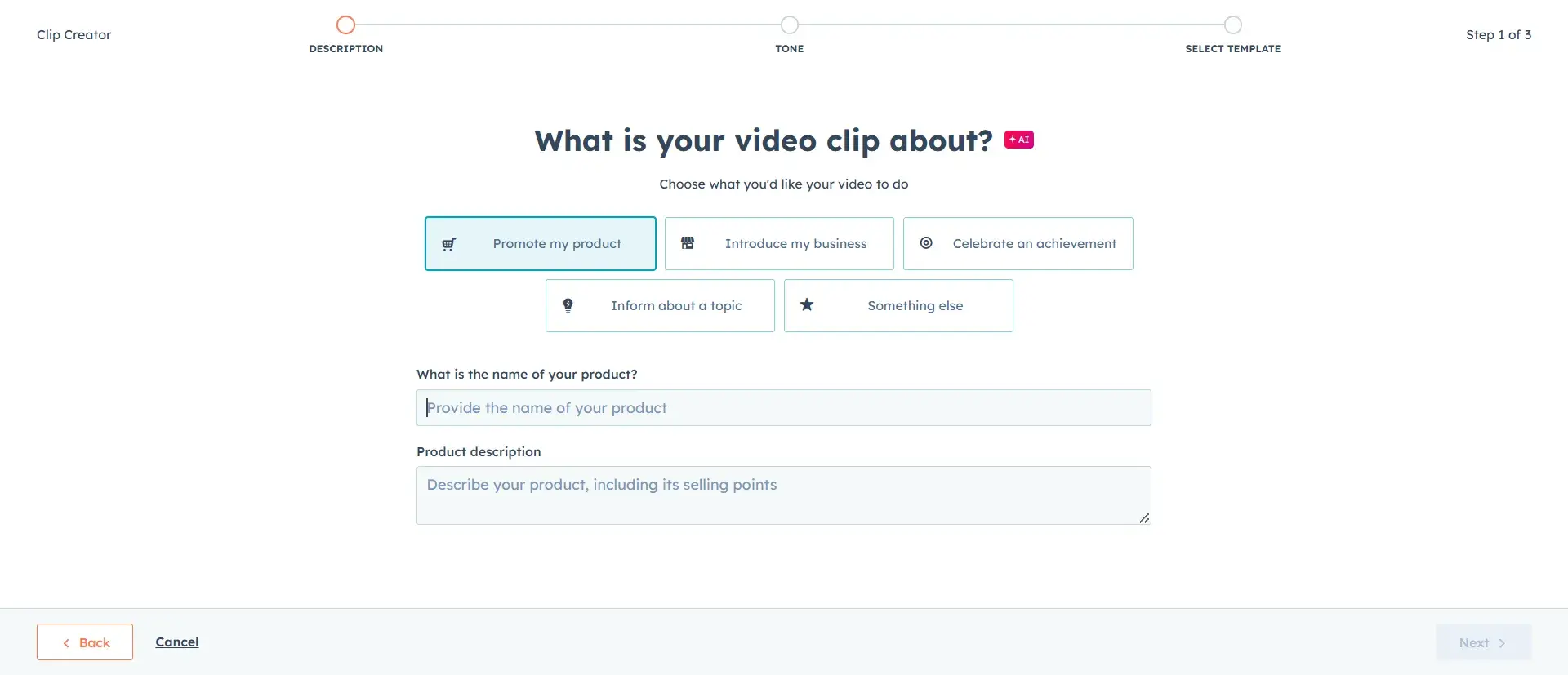
Our team struggled with scalability issues for months – especially when we had to create localized product demos for different market segments.
Had we known about Clip Creator back then, we could have turned a master script into multiple versions, each tailored to specific industry use cases, without the resource strain we experienced.
Looking at our video strategy now, it’s clear that AI-powered tools could have helped us maintain consistent quality across all of our content, not just our big-budget pieces.
The ability to create professional videos for every stage of the buyer’s journey while maintaining brand consistency and compliance would have significantly improved our content velocity.
Create real connections
At first, I thought expertise in video marketing meant mastering high-end equipment and complex production techniques.
However, after digging into the data and trends, I realized that true success lies in making real connections through storytelling.
One of my biggest takeaways was realizing the transformative potential of AI in video production.
Looking back, I see how AI-powered tools could have streamlined our entire process, allowing us to maintain consistent quality across all content, not just high-budget projects.
Change is constant in video marketing. As you implement this strategy, conduct regular quarterly strategy reviews, closely track performance, and adapt your approach based on data and changing audience needs.
By keeping your strategy flexible and audience-focused, you make your B2B videos an essential part of your B2B marketing toolkit.


